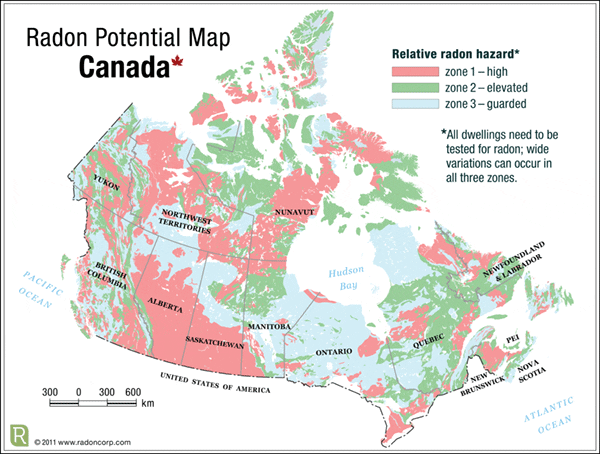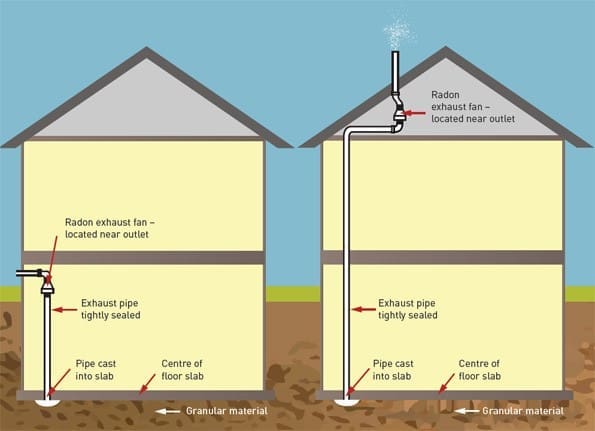Tout ce qu’il faut savoir sur la présence du radon dans les demeures

Invisible and odourless, radioactive radon gas occurs naturally in the environment when the uranium in rocks and soil breaks down. Although the gas does not pose a risk when outdoors, radon can be a health hazard if it gets trapped indoors.
This National Safety Month, we want to equip you with some basic information about this potentially dangerous gas, how you can detect it and how to reduce the amount in your home.
How does radon affect my health?
Radon gas can negatively impact on your health, especially in your lungs.
Exposure to this gas over time is a leading cause of lung cancer among non-smokers. The gas may be related to 16% of all fatal lung cancer cases and roughly 3,300 Canadian deaths per year. Additionally, smokers are at an increased risk of developing lung cancer if they are exposed to dangerous levels of radon.
Despite these serious health concerns, Health Canada says only 6% of people test their homes for radon. In fact, a study of the Calgary area discovered that 1 in 8 homes tested contained radon levels higher than 200 Bq/m3, Health Canada’s maximum safe limit—which is already double the recommendation from the World Health Organization.
How does radon get into my home?
Since radon gas is a product of rock and soil breakdown, radon usually enters your home from basement levels. Most commonly, radon can seep in through cracks in your windows fittings, foundation walls, gaps around pipes, floor drains, construction joints or in your water supply.
If the gas becomes trapped in an enclosed space, the levels could increase and become a greater health risk. Basements and crawl spaces will usually have the highest amounts of radon since they are closer to the source and are generally not as well-ventilated.
Where are radon levels highest?
Radon gas is a natural product of uranium decay in the environment, so it is difficult to predict where levels might be highest. Radon is found everywhere in Canada—no regions are “radon-free.” While some provinces have higher hazard zones, individual houses should still be tested because there could be vast variations within those areas. Furthermore, concentrations could become higher and pose a greater risk if the gas enters your home.

| Image source: Radon Environmental Management Corporation. 2011 |
How do I test for radon in my home?
When it comes to detecting radon levels in your house, you have a couple options. You can purchase a do-it-yourself kit from a local hardware store or you can hire a certified C-NRPP radon measurement professional. No matter which option you choose, it is recommended that your home is tested for a minimum 3-month period.
The best place to conduct the radon test is in your basement or the lowest level in your home that is regularly used to establish the most accurate reading of the level of radon that you and your family are exposed to.
How do I reduce the amount in my home?
If you discover that you’re living in high levels of radon gas, you will need to ventilate your house to redirect the radon outdoors and seal any openings through which the gas may be coming in.
To ensure that you’re ventilating effectively, you should consult a C-NRPP radon mitigation professional to help you create a plan.
Depressurization
The most common method of mitigating radon levels is active soil depressurization. A C-NRPP professional will install a small pump in your basement sub-flooring to reverse the air pressure difference between the house and the soil. This will redirect the gas to the outdoors before it can enter your home.

| Image source: https://www.canada.ca/en/health-canada/services/environmental-workplace-health/reports-publications/radiation/radon-reduction-guide-canadians-health-canada-2013.html |
There are other methods of depressurization that vary depending on your home and where the radon levels are highest. Your drainage system or sump-hole, for example, can be fitted with a suction system to draw the gas away from your home.
Sealing
You can seal open sumps and floor drains with special covers that can still allow water through while preventing radon from entering your house. Cracks in walls or construction joints can be sealed with caulking, while exposed soil in crawl spaces can be covered with a plastic membrane.
Mechanical Ventilation
You might consider using a heat or energy recovery ventilator (HRV or ERV) to increase the ventilation in your home. By venting air outdoors, this system will also reduce the radon levels.
After installing a mitigation system, make sure you conduct follow-up tests to ensure that it’s working effectively.
This National Safety Month, keep your family’s health in mind and consider testing your home for radon gas. For more information on detecting and mitigating radon in your home, visit the C-NRPP website.
Now that you’ve learned about radon symptoms, discover other ways to keep your home safe on the AMJ blog.

